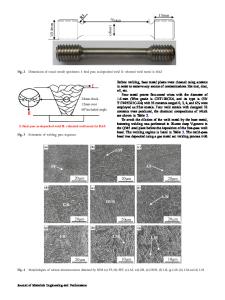Macro- and Microstructure of Metals
Old crafting techniques used in the production of metal objects can be understood by structure analyses from both the macroscopic to microscopic scale. This mainly applies to copper with its alloy components tin, lead and zinc, furthermore to iron and/or
- PDF / 30,368,924 Bytes
- 605 Pages / 504.568 x 737.009 pts Page_size
- 104 Downloads / 522 Views
Andreas Hauptmann
Archaeometallurgy – Materials Science Aspects
Natural Science in Archaeology Series Editors Günther A. Wagner, Hirschhorn, Germany Christopher E. Miller, Institut für Naturwissenschaftliche Eberhard-Karls-Universität Tübingen, Tübingen, Germany Holger Schutkowski, School of Applied Sciences, Talbot Campus Bournemouth University, Poole, Dorset, UK
The last three decades have seen a steady growth of application of natural scientific methods to archaeology. The interdisciplinary approach of archaeometry has found increasing appreciation by the archaeologists and is now considered indispensable and an integral part of archaeological studies. Interdisciplinary collaboration requires a multidisciplinary background. It is becoming increasingly difficult for the individual to grasp the whole field of archaeometry with its rapid developments. The aim of the series Natural Science in Archaeology is to bridge this information gap at the interface between archaeology and science. The individual volumes cover a broad spectrum of physical, chemical, geological, and biological techniques applied to archaeology as well as to palaeoanthropology with the interested nonspecialist in mind. The single monographs cover: – large fields of research – specific methods of general interest (archaeometric methods of dating, material analysis, environmental reconstruction, geophysical prospecting, remote sensing and data processing) – materials of interest to the archaeologist, such as sediments, soils, metal and nonmetal artifacts, animal and plant remains and other organic residues – practical aspects such as sampling and data interpretation – case studies, to demonstrate the potential and limitations of the various techniques.
More information about this series at http://www.springer.com/series/3703
Andreas Hauptmann
Archaeometallurgy – Materials Science Aspects
Andreas Hauptmann Haus der Archäologien, Archaeometallurgy Deutsches Bergbau-Museum / Ruhr University Bochum, Germany
ISSN 1613-9712 Natural Science in Archaeology ISBN 978-3-030-50366-6 ISBN 978-3-030-50367-3 https://doi.org/10.1007/978-3-030-50367-3
(eBook)
# Springer Nature Switzerland AG 2020 This work is subject to copyright. All rights are reserved by the Publisher, whether the whole or part of the material is concerned, specifically the rights of translation, reprinting, reuse of illustrations, recitation, broadcasting, reproduction on microfilms or in any other physical way, and transmission or information storage and retrieval, electronic adaptation, computer software, or by similar or dissimilar methodology now known or hereafter developed. The use of general descriptive names, registered names, trademarks, service marks, etc. in this publication does not imply, even in the absence of a specific statement, that such names are exempt from the relevant protective laws and regulations and therefore free for general use. The publisher, the authors, and the editors are safe to assume that the advice and information in this book are believed to be true an











